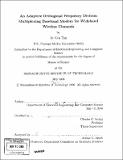An adaptive Orthogonaly Division Multiplexing baseband modem for wideband wireless communication
Author(s)
Tan, Jit Ken
DownloadFull printable version (10.40Mb)
Other Contributors
Massachusetts Institute of Technology. Dept. of Electrical Engineering and Computer Science.
Advisor
Charles G. Sodini.
Terms of use
Metadata
Show full item recordAbstract
This thesis shows the design of an Orthogonal Frequency Division Multiplexing base-band modem with Frequency Adaptive Modulation protocol for a wideband indoor wireless channel. The baseband modem is implemented on a Field Programmable Gate Array and uses 294,939 2-input NAND gates with a clock frequency of 128 MHz. The Frequency Adaptive Modulation algorithm is 6% of the entire baseband modem which means that it is of low complexity. The baseband modem is then integrated with a RF Front End. The maximum transmit power of the RF Front End is 7.5 dBm. This prototype takes 128 MHz of bandwidth and divides it into 128 1-MHz bins. The carrier frequency is at 5.25 GHz. Measurements are taken with this prototype to investigate the concept of Frequency Adaptive Modulation. With a target uncoded Bit Error Rate of 10-3, it is found at distances of 1.0m to 10.8m, the data rate varies from 355 Mbps to 10 Mbps. The average data rate of this system is 2.57 times the average data rate without Frequency Adaptive Modulation. The fact that a Rayleigh channel is decomposed into Gaussian sub-channels through Frequency Adaptive Modulation is also verified.
Description
Thesis (S.M.)--Massachusetts Institute of Technology, Dept. of Electrical Engineering and Computer Science, 2006. Includes bibliographical references (p. 119-122).
Date issued
2006Department
Massachusetts Institute of Technology. Department of Electrical Engineering and Computer SciencePublisher
Massachusetts Institute of Technology
Keywords
Electrical Engineering and Computer Science.